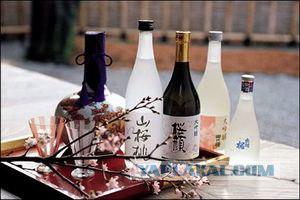713
Interestingly about Sake
It turns out that the Japanese Sake is brewed about since that time began to grow his home today crop - rice. And 300 years BC this drink has been part of everyday life. According to legend, the first sake was brewed as a beverage intended to sacrificial offerings to the gods to appease them and thus to ensure the harvest period in the cultivation of rice.
It is known that in the chronicle "Nihongi" 720 AD mentions the subjects of the Emperor Syudzin worshiping the deity of rice wine "Omiva no Kami." In addition to this deity in Japanese mythology there were several mythical characters associated with the rice wine - "Matsuo Shrine" and "Umemi Shrine." He dedicated several temples in Nara and Kyoto.
Initially, the right manufacturing sake had only members of the imperial family, is the ability to later adopted by Buddhist monks, and only in the Middle Ages, this drink for their own consumption have been producing farms. And although today the technology of production of sake improved, it uses the secrets that have been used by masters of sake for millennia.
Japan - a wonderful country. It is unique all - cities, language and culture. Why do we have in the country of the Rising Sun as inexplicable charm? The main reason probably lies in the fact that the Japanese always and everywhere know how to find harmony. The culture of the Japanese national drink "Sake" - one of the most important manifestations of this skill. Sake - it is not just a drink, it's heritage and centuries-old traditions of Japan, which are transmitted from generation to generation for more than one millennium.
The Japanese used to refer to this drink a lot of words, the main of which - "sake", "Osaka", "Seishi" or "nihonshu." Japanese restaurant realize any of them. We often hear as a synonym for the word "sake" expression "rice wine". But it should be amended. Sake - it's not vodka or wine, a special drink. The process of its production resembles the preparation of Roma, where instead of sugar cane used in Fig.
The vast majority of varieties of sake has a fortress from 14 to 20 degrees. The consistency sake closest to the thick liquor or wine. Although some believe that this is just a rather weak brew. The main advantages of this drink lies in the fact that it is low in calories and is made exclusively from natural products. Sake is made from rice and pure spring water.
The finished product is evaluated on four main criteria: "a sweet / tangy" and "easy / hard." As a rule, ease checked for dryness. That is, the stronger the sake, the drier and rougher taste it. With such a measure as "sweet / sharp" things easier. The higher the corresponding number, the sweeter sake. A higher number of visual means, that this drink will burn your tongue like pepper.
The culture of drinking.
With regard to the consumption culture of sake, here there are some rules. Pours sake of a small ceramic pitcher (tokkuri) in a small cup (Choco), calculated for only two or three sips. According to the rules, made to pour sake immediately before each toast, and fill your own cup is considered bad manners.
So if you happen to go on the road together with Japanese sake, your guests will closely monitor the filling your glass and will be very glad if you, in turn, pay attention to his glass. And if you are the only one of us who drink sake, then you can make love for and pour the beverage into the cup. In this case, it polite to keep on weight.
Sake belongs to the rare in the world of drinks that drink and heat and cooling. Sake has a fairly wide temperature range of drinking - 33-55 ° C. For some, there is nothing more delicious than Sake at room temperature. Others prefer sake with a piece of ice. Experts say that the language of the person most acutely perceives the taste at 15-30 ° C.
Since drinking sake? It dictates the situation: light and sweet sake is better to drink chilled on a hot summer day. A chilly windy, strong drink and hot sake. It is heated in a special vessel to room temperature. This way of eating Japanese beverage called "kan-Zack." For this purpose it is poured into a special ceramic vessel and placed in a water bath. The main thing that sake is not overheated - in this case it loses its flavor.
Japanese themselves often drink cold sake, believing that it allows a more subtle taste of the drink. Professional tasters distinguish 90 shades of flavor. Sake features a variety of rich fruit notes.
What drink sake? Sake is universal: it perfectly matches not only with key Japanese cuisine, but also chips, cheese, nuts and snacks. Everything else, sake is used in the preparation of traditional Japanese dishes. So, if the frying trout pour her a drink diluted, it becomes a kind of taste, in addition, fighting off the smell of the river. In the preparation of the puffer fish is also used Sake: specially trained chefs poured sake fried fins of the fish. The Japanese say that where drinking sake, friendship is born. And it is not a declaration - taking ceremony of sake has to really warm feeling. In art, the Japanese drink sake embodied courtesy. Sitting over a cup of sake, the parties talk about anything - and as soon as the topic of conversation you get tired, take a carafe of sake and mean person next. So, logically, you wind up his speech, and can now speak for ourselves, it will be carefully and sympathetically to listen to you. And do not forget before each toast to say "Compay", which means to the bottom.
The production process
The heyday of the production of sake came in the Edo period (1600-1868). Centre began its manufacturing Kinki area, the area of the current prefectures of Kyoto, Hyogo and Osakak. It was believed that the best time for the production of beverage - January and February, so the first time it produced during those months.
This sake is called "kudaridzake." A process for preparing the drink in those days was very picturesque, but not very hygienic. Rice grain just chewed and spat into wooden containers, which without any ploys and is fermented. Cleaner sake began to receive only in the 12th century. In the industrial scale, the drink began to produce the 17th century.
For the preparation of sake rice and take a large cave in him. And as a result of the initial amount may remain quite a bit. In the case of the preparation of the elite varieties - only thirty per cent is usually the same - about seventy. Then rice is washed, soaked, and then subjected to steam.
About a quarter of the rice is prepared to create a ferment, which cooled to 30 degrees, and then for about 35 hours and kept in a hot humid environment - To make the fungal culture to feel completely comfortable. Then, the resulting mash is mixed with yeast and steamed rice, all covered with water. The fermentation process takes approximately three months. Then drink purified, filtered and pasteurized.
As a result of two components - water and rice - derived thousand kinds of sake, roznyaschihsya subtle shades of color, flavor, density, "velvety", transparency, strength (maximum - 20 degrees). As is known, sake supposed to have a hint of golden nebula - though there is a lot of options. Young sake must have a barely noticeable lemon, almost greenish tint. Some older varieties of sake are almost amber hue. But until now, the biggest mystery is how the drink fruity notes appear.
Within the limits of even a small town it is usually done with a hundred different kinds of sake. Although the older generation of Japanese complained that the producers each year becomes smaller, the official statistics take into account more than 2 thousand. The most widely used grade of purified sake - "Sais". It is colorless and tastes like sherry, but some prefer the more ancient crude sake - "nigoridzake" yellowish and somewhat bitter taste.
In contrast, wines and other alcoholic sake differs precocious harvest, and by categories - "Ikkyu" (first class) and "Nikki" (second grade) - depending on the tax rate (this classification was introduced in 1992). Typically, sake or bottled in glass bottles several liters or in small bottles (720, 500 or 300 ml) and even aluminum cans.
As well as a few centuries ago, today there are three important elements necessary for the preparation of sake: quality rice, good water and cool all year round climate. If the wine is paramount quality of the grapes, for the sake - of course, the quality of rice.
via kunzite

Source:
It is known that in the chronicle "Nihongi" 720 AD mentions the subjects of the Emperor Syudzin worshiping the deity of rice wine "Omiva no Kami." In addition to this deity in Japanese mythology there were several mythical characters associated with the rice wine - "Matsuo Shrine" and "Umemi Shrine." He dedicated several temples in Nara and Kyoto.
Initially, the right manufacturing sake had only members of the imperial family, is the ability to later adopted by Buddhist monks, and only in the Middle Ages, this drink for their own consumption have been producing farms. And although today the technology of production of sake improved, it uses the secrets that have been used by masters of sake for millennia.
Japan - a wonderful country. It is unique all - cities, language and culture. Why do we have in the country of the Rising Sun as inexplicable charm? The main reason probably lies in the fact that the Japanese always and everywhere know how to find harmony. The culture of the Japanese national drink "Sake" - one of the most important manifestations of this skill. Sake - it is not just a drink, it's heritage and centuries-old traditions of Japan, which are transmitted from generation to generation for more than one millennium.
The Japanese used to refer to this drink a lot of words, the main of which - "sake", "Osaka", "Seishi" or "nihonshu." Japanese restaurant realize any of them. We often hear as a synonym for the word "sake" expression "rice wine". But it should be amended. Sake - it's not vodka or wine, a special drink. The process of its production resembles the preparation of Roma, where instead of sugar cane used in Fig.
The vast majority of varieties of sake has a fortress from 14 to 20 degrees. The consistency sake closest to the thick liquor or wine. Although some believe that this is just a rather weak brew. The main advantages of this drink lies in the fact that it is low in calories and is made exclusively from natural products. Sake is made from rice and pure spring water.
The finished product is evaluated on four main criteria: "a sweet / tangy" and "easy / hard." As a rule, ease checked for dryness. That is, the stronger the sake, the drier and rougher taste it. With such a measure as "sweet / sharp" things easier. The higher the corresponding number, the sweeter sake. A higher number of visual means, that this drink will burn your tongue like pepper.
The culture of drinking.
With regard to the consumption culture of sake, here there are some rules. Pours sake of a small ceramic pitcher (tokkuri) in a small cup (Choco), calculated for only two or three sips. According to the rules, made to pour sake immediately before each toast, and fill your own cup is considered bad manners.
So if you happen to go on the road together with Japanese sake, your guests will closely monitor the filling your glass and will be very glad if you, in turn, pay attention to his glass. And if you are the only one of us who drink sake, then you can make love for and pour the beverage into the cup. In this case, it polite to keep on weight.
Sake belongs to the rare in the world of drinks that drink and heat and cooling. Sake has a fairly wide temperature range of drinking - 33-55 ° C. For some, there is nothing more delicious than Sake at room temperature. Others prefer sake with a piece of ice. Experts say that the language of the person most acutely perceives the taste at 15-30 ° C.
Since drinking sake? It dictates the situation: light and sweet sake is better to drink chilled on a hot summer day. A chilly windy, strong drink and hot sake. It is heated in a special vessel to room temperature. This way of eating Japanese beverage called "kan-Zack." For this purpose it is poured into a special ceramic vessel and placed in a water bath. The main thing that sake is not overheated - in this case it loses its flavor.
Japanese themselves often drink cold sake, believing that it allows a more subtle taste of the drink. Professional tasters distinguish 90 shades of flavor. Sake features a variety of rich fruit notes.
What drink sake? Sake is universal: it perfectly matches not only with key Japanese cuisine, but also chips, cheese, nuts and snacks. Everything else, sake is used in the preparation of traditional Japanese dishes. So, if the frying trout pour her a drink diluted, it becomes a kind of taste, in addition, fighting off the smell of the river. In the preparation of the puffer fish is also used Sake: specially trained chefs poured sake fried fins of the fish. The Japanese say that where drinking sake, friendship is born. And it is not a declaration - taking ceremony of sake has to really warm feeling. In art, the Japanese drink sake embodied courtesy. Sitting over a cup of sake, the parties talk about anything - and as soon as the topic of conversation you get tired, take a carafe of sake and mean person next. So, logically, you wind up his speech, and can now speak for ourselves, it will be carefully and sympathetically to listen to you. And do not forget before each toast to say "Compay", which means to the bottom.
The production process
The heyday of the production of sake came in the Edo period (1600-1868). Centre began its manufacturing Kinki area, the area of the current prefectures of Kyoto, Hyogo and Osakak. It was believed that the best time for the production of beverage - January and February, so the first time it produced during those months.
This sake is called "kudaridzake." A process for preparing the drink in those days was very picturesque, but not very hygienic. Rice grain just chewed and spat into wooden containers, which without any ploys and is fermented. Cleaner sake began to receive only in the 12th century. In the industrial scale, the drink began to produce the 17th century.
For the preparation of sake rice and take a large cave in him. And as a result of the initial amount may remain quite a bit. In the case of the preparation of the elite varieties - only thirty per cent is usually the same - about seventy. Then rice is washed, soaked, and then subjected to steam.
About a quarter of the rice is prepared to create a ferment, which cooled to 30 degrees, and then for about 35 hours and kept in a hot humid environment - To make the fungal culture to feel completely comfortable. Then, the resulting mash is mixed with yeast and steamed rice, all covered with water. The fermentation process takes approximately three months. Then drink purified, filtered and pasteurized.
As a result of two components - water and rice - derived thousand kinds of sake, roznyaschihsya subtle shades of color, flavor, density, "velvety", transparency, strength (maximum - 20 degrees). As is known, sake supposed to have a hint of golden nebula - though there is a lot of options. Young sake must have a barely noticeable lemon, almost greenish tint. Some older varieties of sake are almost amber hue. But until now, the biggest mystery is how the drink fruity notes appear.
Within the limits of even a small town it is usually done with a hundred different kinds of sake. Although the older generation of Japanese complained that the producers each year becomes smaller, the official statistics take into account more than 2 thousand. The most widely used grade of purified sake - "Sais". It is colorless and tastes like sherry, but some prefer the more ancient crude sake - "nigoridzake" yellowish and somewhat bitter taste.
In contrast, wines and other alcoholic sake differs precocious harvest, and by categories - "Ikkyu" (first class) and "Nikki" (second grade) - depending on the tax rate (this classification was introduced in 1992). Typically, sake or bottled in glass bottles several liters or in small bottles (720, 500 or 300 ml) and even aluminum cans.
As well as a few centuries ago, today there are three important elements necessary for the preparation of sake: quality rice, good water and cool all year round climate. If the wine is paramount quality of the grapes, for the sake - of course, the quality of rice.
via kunzite

Source:






















